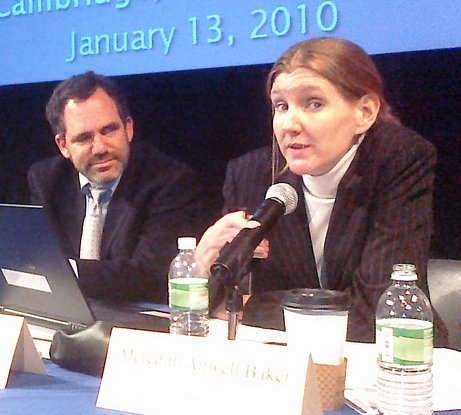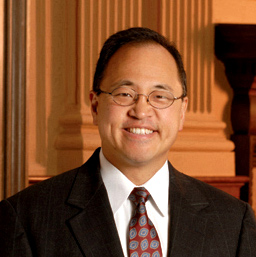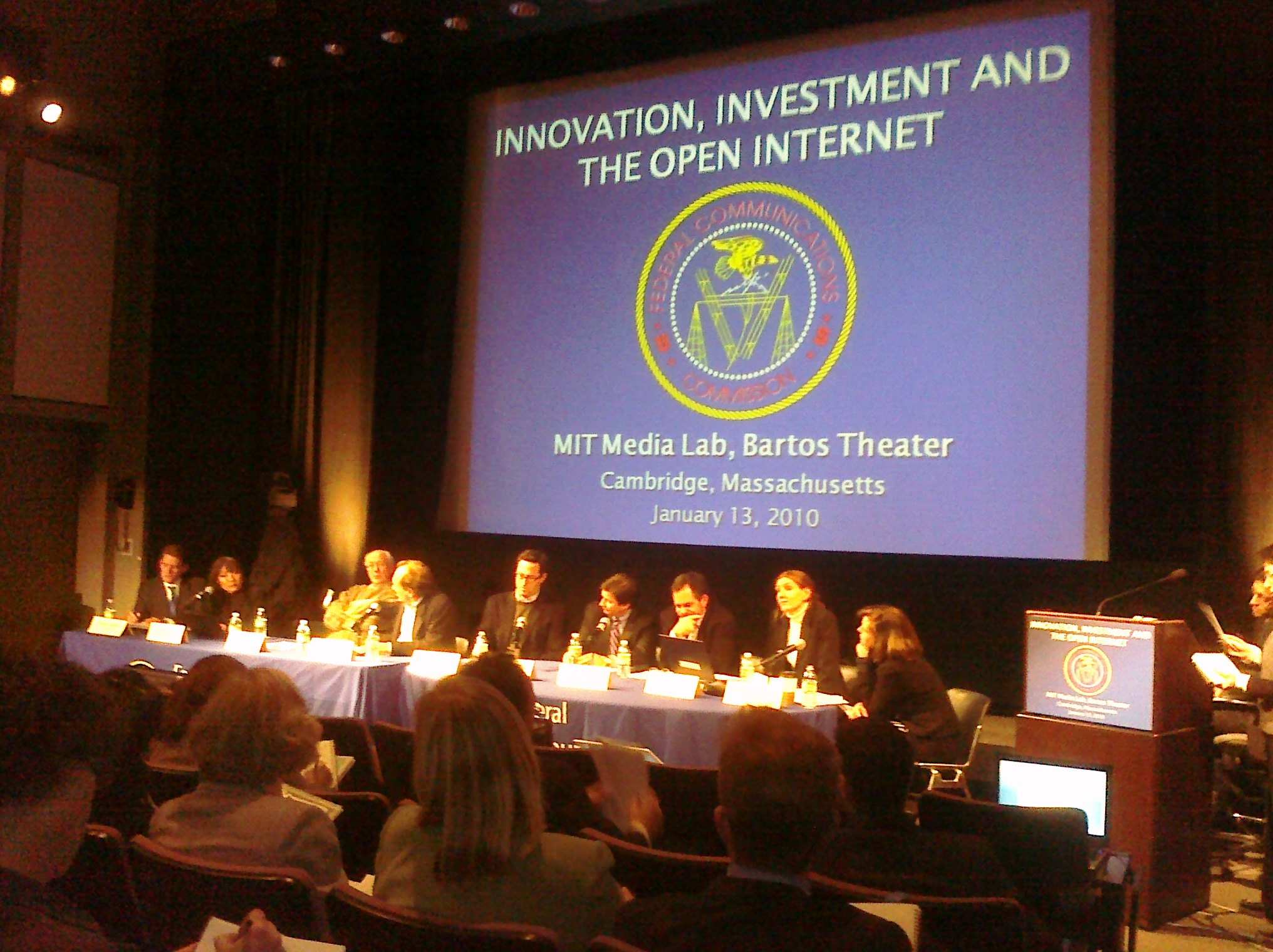4:50 pm Panelist Presentations
Barbara van Schewick, Assistance Professor of Law, Stanford Law School
Three Stories: First, EBay, a huge success with 88 million people world wide use EBay
 Internet built on design principle called end-to-end (E2E) arguments described Saltzer, Clark and Reed in 1981 [PDF]. Network provides only general services of broad utility across applications; Network not optimized in favor of specific applications; all application-specific functionality at end hosts. Network is general. The Network is application-blind. Innovators decide what they want to build. Users decide what applications they want to use. Low cost for innovation. Many people can innovate.
Internet built on design principle called end-to-end (E2E) arguments described Saltzer, Clark and Reed in 1981 [PDF]. Network provides only general services of broad utility across applications; Network not optimized in favor of specific applications; all application-specific functionality at end hosts. Network is general. The Network is application-blind. Innovators decide what they want to build. Users decide what applications they want to use. Low cost for innovation. Many people can innovate.
Second Story: Skype
Third Story: Google Video
Today service providers can control the applications and content on their networks; they may do so in order to increase profits, exclude unwanted content, or manage bandwidth. By singling out specific applications, network providers start picking winners and losers on the Internet. Innovators cant innovate; Investors don’t invest.
Measures that increase the costs of application innovation reduce the number of innovations that will be justified and reduce the size and diversity of the pool of potential innovators. Enabling widespread experimentation at the application-level and enabling users to choose the applications they prefer is at the heart of the mechanism that enables innovation.
Widespread experimentation of applications, between users and innovators. Users and network providers use different criteria for what applications will be successful. Network providers will have different criteria (does this compete with one of my applications, does it consume my bandwidth). Consider Skype. Many mobile providers do not permit consumers to use Skype because it keeps users from using their service.
No body knows if an application will be successful until users try it; network providers can not replicate this. If network service providers pick winners and losers, then users will get applications that they would not have otherwise have chosen.
Low cost of innovation makes many more applications worth pursuing and allow a more diverse group to become innovators.
Why do we care about innovation: it contributes to economic growth and creates value for society. Did you ever try to explain to a grandmother why they should get the Internet? You don’t explain that it sends data packets back in forth. You explain that if you get the Internet, you can get pictures of grandchild and allows you to read about anything. The Internet creates value by allowing us to do the things that we want to do. Applications are the means for allowing us to do these things.
Prof. Shane Greenstein, Elinor and H. Wendell Hobbs Professor, Kellogg School of Management, Northwestern University, Transaction Cost,  Transparency, and Innovation for the Internet
Transparency, and Innovation for the Internet
Open has many meanings; the meaning in this talk is communications between partners in a value chain and transaction costs: Cost of setting up new process to create value: Cost of executing series of actions within a value chain
The important economic role of transparency and consistency for lowering those transaction costs: Lowering transaction costs supports wide participation in innovative activity.
Internet is the basis for a wide array of services and economic activity
The Legacy: Collective invention is a process in which improvements or experimental findings are regularly shared
It becomes something different when it commercializes. What’s new with the commercial internet: Platform: reconfigurable based on compatible components. The Internet today is a network of platforms. The second thing that has changed is broadband concentration which has resulted in small set of carriers in local markets with market power. This raises a traditional concern about prices.
Transaction Costs: Transparency. Participants know what changes are imminent. Participants actively inform others in advance. Any participant can learn info without restriction. Originally the Internet was quite transparent.
Other Change: Consistency: Processes and policies for interacting with other firms change slowly (at most). Matters because it shapes return on investments (ROI). Entrepreneurs & VCs dislike inconsistency. Opportunistic pricing or renegotiation costs.
Factors shaping ability to capture value. From broadband firms with market power? In developing apps that work with multiple ISPs
What Shapes Participation in Innovation: Processes for soliciting input in decisions Drawbacks: costs of notifying/communicating, strategic costs from giving up control over direction, slowing speed of decision: Gain: additional info. Variety of opinions.
Conjecture: Gains to industry far higher than cost of transparency and consistency. Transparency & consistency increase participation in innovative activity. In a competitive setting, those without transparency wont work with partners and will have trouble in market. Firms with market power, platform providers have weak incentives to be transparent & consistent.
What Shapes (Re)negotiation: Interdependence + changing opportunity means partners must reconsider in time and frequently: Concern about powerful firm using negotiating position to limit what information they give others. Worry about take it or leave it offers, or refusal to deal. Hid behind lack of transparency & lack of consistency.
When all broadband ISPs look less transparent and/or consistent, what then? ISP owns users and applications. Transaction costs for innovation increase. Decline in breadth of participation and in extent of innovation.
Summary
Wide participation in innovative activity encouraged by transparency and consistency: Lowers transaction costs of participants in interdependent value chain. Concern: Incentives of broadband firms w/market power & platform vendors to be transparent or consistent?
If commercial Internet necessitates some active role for management at carriers… Implication of unrestrained discretion? In presence of market power at broadband firms & rise of platform vendors?
Glimmers and Signs of Innovative Health in the Commercial Internet (2009)
Marcus Weldon, Corporate CTO, Alcatel-Lucent, Innovation and Investment in the Internet: Past, present and future
The Internet is a series of interconnected private, managed IP networks and public networks that connect through transit links and peering links. It is Open because any user can connect to any internet application located anywhere on the internet from anywhere else on the internet. The Open Internet supports ‘best effort’ transport, with no service guarantees, but ~equal usage of the resources between users connected via the same access ‘on ramp’. The ‘on-ramps’ to the Open Internet are primarily provided over managed IP networks, which also support managed services with specific QoS guarantees
But not all Internet services are equally accessible:
• Content Data Networks (CDNs) enhance delivery of content
• Networks of Data Centers enhance access to applications
• Different service tiers are offered to improve users’ access
Best Effort Services and Managed Services : What’s the Difference?
Best Effort services : Typically delivered from a web server on the Open Internet to the client, using the Managed IP network as an Internet ‘on ramp’
Managed services: Typically delivered from a web server within the Managed IP network to the client and only traverse the Managed IP network
(Demonstrations of how different services fit within these models, some hybrids – more diverse array of applications is better, giving user ability to chose)
What led to the success of the Open Internet and what harms it?
Investment in Content and Applications – was helped by openness of Internet (key factor), affordable broadband, convergence of networks to IP, simplicity of IP, proliferation of IP-enabled devices – was hampered by bandwidth limitations, limited reach of infrastructure, security and rights concerns, usage of IP-enabled devices, and poor quality of experience.
Investment in network infrastructure – was helped by FTTx-promoting regulation, competition, demand, network convergence, massive IP market – was hampered by FTTx hampering regulations, geographies and topologies, cost of networks, lack of competition.
Open is good; but have to have the ability to afford the bandwidth.
What’s the problem: While network revenue (per subscriber) used to exceed cost, revenue and cost have converged (mobile cost is forecast to exceed revenue). It is bad for everyone for the network to go out of business.
What’s the solution: managed services for revenue sharing and investment for good of all. Allow user to select QoS for the applications that they want; increasing revenue for network. Experience gets better; more applications developed. Even Best Effort network experience will improve.
5:41 pm
Jeffrey Glueck, CEO, Skyfire, Perspective of a Mobile Application Developer and Entrepreneur
skyfire launched in 2009 after three years of development. skyfire is a fast mobile web browser that supports all of the rich media on the web, allowing users to watch any video on the web including Flash, Silverlight, and Real Player, and to visit any website (not just mobile sites). It is free and downloadable from the skyfire website, and runs on Windows Mobile, and Nokia N and E Series phones.
Features of Internet that have given confidence and predictability for Investment: Mass Scale; Interoperability; Low Barriers to Entry; and Adequate Infrastructure. One website would work on any computer (Dell, Apple, IBM). Did not have to be approved to get into marketplace. Knew that photos on website could get through the network.
Mobile Internet presents new challenges: Closed proprietary standards create fragmented markets, lowers ROI per unit of effort. Lack of interoperability
Three obstacles to innovating on the “closed” mobile Internet: (1) Freedom of the consumer to choose apps and defaults; (2) Lack of Transparency and consistency on network management practices, and discriminatory requirement for proprietary protocols; (3) Uncertainty on non-discriminatory and adequate data throughput.
Skyfire has to date held back from developing for iPhone because of cost of development, Apple’s rule against duplicate functionality and opposition to Adobe Flash playing on the iPhone. This is a limit on Skyfire’s ability to improve the browsing experience.
Carriers block certain ports, do not disclose port blocking practices, throttle RTSP streaming, and block applications from their stores. Apple declare video must use HTTP streaming; our app was not designed for HTTP streaming, our protocol is better, but not allowed to use it.
Non discrimination should be hallmark of network management.
Concern: take of allowing biggest players to colo servers inside ISP host; if it is not provided equally to other firms, that means new entrants don’t have a chance because they cannot afford to collocate.
“Mobile Warming.” Browsers provide key interoperability to enable competition. Browsers allow small entrants. Publishers can not be expected to build and maintain apps for each OS/Hardware permutation and version.

 One interesting question is which historical developments were inevitable and which could have come out differently (e.g., was World War I inevitable?). It is impossible to know, of course, but in communications policy most commentators believe that many developments that we take for granted were historically contingent. For instance, if in the early 20th century telephone companies had (either by choice or mandate) allowed interconnection (so that customers of one network could call the customers of another network), we might not have ended up with a single company as the dominant telephony provider for most of the 20th century. Another example flows from the fact that, in allotting television stations, the FCC chose to emphasize localism. If it had instead emphasized national competition, we might have ended up with more national networks, but at the expense of having regional rather than local stations. The Internet is particularly fertile ground for historical contingency. If AT&T had not agreed in a 1956 consent decree to refrain from providing computer services, it might have dominated the field from the beginning. If a few engineers working with the Department of Defense had created their protocols a bit differently, it might be much harder to connect, and add your own voice, to the Internet. And if the government had decided to create a more easily controllable network, preventing someone like Tim Berners-Lee from adding his code on top of the existing protocols, we might not have the Web as we know it.
One interesting question is which historical developments were inevitable and which could have come out differently (e.g., was World War I inevitable?). It is impossible to know, of course, but in communications policy most commentators believe that many developments that we take for granted were historically contingent. For instance, if in the early 20th century telephone companies had (either by choice or mandate) allowed interconnection (so that customers of one network could call the customers of another network), we might not have ended up with a single company as the dominant telephony provider for most of the 20th century. Another example flows from the fact that, in allotting television stations, the FCC chose to emphasize localism. If it had instead emphasized national competition, we might have ended up with more national networks, but at the expense of having regional rather than local stations. The Internet is particularly fertile ground for historical contingency. If AT&T had not agreed in a 1956 consent decree to refrain from providing computer services, it might have dominated the field from the beginning. If a few engineers working with the Department of Defense had created their protocols a bit differently, it might be much harder to connect, and add your own voice, to the Internet. And if the government had decided to create a more easily controllable network, preventing someone like Tim Berners-Lee from adding his code on top of the existing protocols, we might not have the Web as we know it.

































 Three major concerns with network neutrality:
Three major concerns with network neutrality:

 Internet built on design principle called end-to-end (E2E) arguments described Saltzer, Clark and Reed in 1981 [
Internet built on design principle called end-to-end (E2E) arguments described Saltzer, Clark and Reed in 1981 [

 The OpenInternet.gov Blog will feature live posts from today’s
The OpenInternet.gov Blog will feature live posts from today’s  TTY: 1-888-TELL FCC (1-888-835-5322)
TTY: 1-888-TELL FCC (1-888-835-5322)